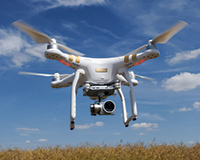 Drones Peter Birkett looks at this emerging area and asks what property owners and occupiers can do to protect themselves
Drones Peter Birkett looks at this emerging area and asks what property owners and occupiers can do to protect themselves
The pace of development in drone law is matched only by their velocity. In recent weeks there have been various drone-related headlines: arrests for flying one at Wimbledon; a near miss at Heathrow; consultation on drone use in the USA; and a Connecticut student enhancing his drone with a semi-automatic pistol.
Concern, but little control
Drone use is becoming an increasing concern for property owners, but current controls are not focused on this aspect of their use. The Civil Aviation Authority (“CAA”) is concerned principally with safety, the Information Commissioner’s Office (“ICO”) takes an interest in the use of data, and the police become involved only if a criminal law has been broken. So who is looking out for the interests of property owners or occupiers? Nobody, it seems.
UK legislation derives from the Air Navigation Order 2009 with separate provisions for drones with and without “surveillance equipment”, which is anything that is equipped to undertake surveillance or data acquisition.
The CAA has now launched the Drone Code, which is a summary of these rules and regulations. Its main provisions are:
- the “pilot” must be reasonably satisfied that the flight is safe;
- direct unaided visual contact must be maintained at all times;
- flights are prohibited around airports without permission;
- flights must be lower than 400ft unless authorised; and
- “aerial work” for which payment is given or promised is only permitted with a CAA licence.
In addition, surveillance aircraft must not fly without CAA authorisation:
- over or within 50m of any congested area;
- over or within 150m of an organised open-air assembly of more than 1,000 people;
- within 50m of any vessel, vehicle or structure not under the control of the person in charge of the aircraft; or
- within 50m of any person unless this is during take-off or landing (where the limit is 30m) or that person is the pilot or someone under the control of the pilot.
Despite a lack of a general privacy law, the ICO is clear that a drone with a camera is potentially covered by the Data Protection Act 1998, as the Metropolitan Police discovered when the National Police Air Service tweeted a picture of comedian Michael McIntyre taken from its helicopter in July this year. The picture was quickly pulled but it highlighted the issue of the use of images taken without consent.
Legal loopholes
This leaves open a series of loopholes through which a drone can, almost literally, be flown. It is not difficult to construct a scenario in which a flight over Buckingham Palace breaks no criminal law. The building is only 24m (80ft) high, so even after adding the minimum 50m clearance there is space below the 400ft ceiling.
There is also a difference in some of the legislation that is not made clear in the Drone Code. While it is unlawful to fly over a congested area or an open-air event at any height, there is no bar, for example, on flying over a building or structure as long as the 50m clearance is observed.
The definition of “aerial work” relies on payment being given or promised, but if a newspaper owns the drone, is it considered “aerial work” when it is paid for photographs obtained or published? Property owners and occupiers do not benefit from any protections so they are vulnerable to intrusion. But does that really matter? The main concerns are personal injury, damage to property, privacy and confidentiality.
The police have made it clear that there is no criminal penalty for breach of privacy unless it amounts to a separate offence such as voyeurism or harassment.
Trespass laws exist, but they rely on identification of the individual who is in control of the aircraft and with live uploading, remote and autonomous operation and a disposable attitude to aircraft loss they are largely ineffective.
Drone use can have a profound effect on property. In California recently, personal drones were being flown close to forest fires, risking collision with the helicopters fighting the inferno. This is not only irresponsible but potentially lethal, yet in the UK it would not necessarily be illegal. Deliberate attack on a person or building would be an offence, but accidental collision may not be.
So, what can owners and occupiers do to protect themselves?
It seems the answer at the moment is very little. The police will only respond if there is a criminal offence and a chance of apprehending the perpetrator. The ICO may be interested if there is a breach of data protection law, but tracking down the source will be difficult.
In the pipeline
Various proposals have been discussed to assist. The term “geo-fencing” is being used to describe in-built programming that prevents intrusion into controlled airspace, but there is no doubt that skilled hackers could render this useless. Registration of each drone at the point of importation and sale would at least allow the last registered use to be tracked if a drone were found.
South Africa has introduced legislation setting a minimum age of 18 and requiring pilots to have a licence and, in some cases, a medical certificate equivalent to that for glider, microlight or balloon pilots. Penalties can be as severe as 10 years’ imprisonment. In contrast, the few UK cases that have reached the courts have involved fines in the hundreds rather than thousands of pounds.
This is an area of law that must develop quickly. There is a recognised interest in protecting property owners and occupiers and the public in general from a hobby that has suddenly become a major commercial business.
Peter Birkett is a senior associate at Howard Kennedy







